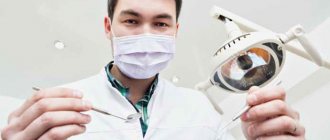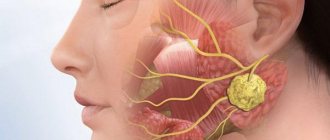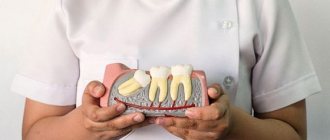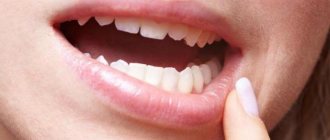The most common dental procedure of tooth extraction no longer scares anyone; it is carried out completely painlessly and without any consequences.
But often the body reacts negatively to interference in its work. The first symptom of a reaction is usually a fever.
What to do in such cases? Should I be afraid or should I calmly exhale with the thought that the body is working to heal the wound?
Reasons for the increase
Temperature is, first of all, a signal from the body that some changes are occurring, something has disrupted the usual course of life.
Several standard reasons for fever after visiting the dentist:
- Reaction to pain after the anesthetic wears off. Pain is always stressful for the body, and the body reacts to stress with apathy, bad mood, weakness, and fever.
- Immune response to a wound in the oral cavity. The mouth contains the maximum amount of bacteria, both beneficial and dangerous, and any wound can become a conductor of infection. By raising the temperature, the body fights infection. It kills all dangerous microbes so that the wound heals faster and does not pose a threat.
- Swelling after injection and removal. Swelling in the oral cavity is an atypical condition and is perceived by the body as dangerous. Too much fluid accumulates in cells and tissues, pressure rises, and the system begins to increase temperature to combat swelling.
- Lymph node reaction. Near the jaw there are cervical lymph nodes; they, like sensitive guards of the whole body, can respond to injuries to surrounding tissues by increasing and, as a result, raising the temperature.
- Psychosomatics. An increase in temperature can be a natural human reaction to stress, fear, and inconvenience. This is especially pronounced if the patient is afraid of dental procedures.
- Allergic reaction. Most often, patients are aware of this feature of the body.
All of the above reasons are completely natural. They mean that the body’s defenses are working, sending signals and dealing with the problems of the consequences of medical intervention.
In these cases, there is no need to see a doctor, everything goes away in a maximum of three days, and the value on the thermometer does not exceed 38.50.
However, there are also more complex and dangerous reasons for deterioration in health. This is a weakening of the immune system against the background of acute respiratory viral infections, influenza, and colds. The stress of tooth extraction can serve as an impetus for the accelerated development of the disease and you need to consult a therapist.
In this case, the pain will not be localized at the site of tooth extraction - this is the main reason to go to the clinic and not to the dentist.
When is fever normal?
By removing a tooth from the hole, the dentist willy-nilly injures the soft tissue. As a result, bleeding begins. The body is a smart system. It reacts to injury with inflammation with some signs: pain, redness, swelling and temperature. In such cases, temperature after tooth extraction is a completely justified phenomenon. The immune system responded correctly. There's no need to worry. There is no need to swallow antibiotics.
The temperature rises on the day of removal. The temperature value may fluctuate. Usually it varies in the range from 36.6ºС to 37ºС. In the evening it always rises, that is, it becomes larger. Sometimes it can reach up to 38ºС. If a person feels exhausted and very ill, you can take an antipyretic pill. Painkillers can be taken only in case of severe pain, which is usually absent with simple removal.
To alleviate the condition, you will have to wait some time (sometimes 2-3 days is enough) until the temperature returns to normal. But there are other more serious cases of complications when its increase is a dangerous signal. We'll talk about them further.
Alarming symptoms
An urgent visit to the dentist is necessary in the following cases:
- Alveolitis.
- Mechanical injury.
- The root of the tooth remained in the hole.
- Hematoma.
Can there be a temperature of 38 or higher after tooth extraction? Yes, and this is not uncommon, and the reason for this can be various factors. Alveolitis is an infectious disease caused by harmful bacteria entering an open wound. Immediately after removal, a clot of dried blood forms in the wound, which the dentist does not clean out, but rather warns not to touch.
It serves as a natural “plug” to close the wound and protect it from the aggressive environment of the oral cavity. By rinsing too vigorously, eating solid foods before the wound has healed, or mechanically brushing your teeth, the clot can be removed, leaving the wound open to infection.
Additional symptoms of alveolitis include bad breath, swelling of the gums or cheeks, the formation of a white purulent plaque on the wound, and enlarged lymph nodes.
The disease is provoked not only by the removal of a clot, but also by smoking immediately after surgery, too hot or cold food, reduced immunity, medical errors during surgery, carious tissue that got into the wound when brushing teeth or during surgery.
Alveolitis is also provoked by mechanical damage to the socket:
- Damaged wall.
- Tooth fragments remaining in the wound.
- Bone injury. Its sharp edges can injure the gums.
- Failure to comply with hygiene or post-operative care recommendations. Brushing your teeth is a great habit, but a hard brush that goes over the extraction site several times can remove the protective layer from the wound and expose it to bacteria.
Injuries during removal are unlikely, but still not excluded. So, when removing the “eights,” the “sevens” can be damaged due to difficult access and the doctor’s limited movement.
It is difficult for the patient to open his mouth so wide and give free access for manipulation. In the lower jaw, wisdom teeth are located close to the jaw ligaments - this can cause jaw injury.
The upper third molars may erupt into the maxillary sinuses. Therefore, when removing them, you can get damaged and there is a risk of developing purulent sinusitis.
Tooth roots that break off during surgery and remain in the wound pose a serious danger to the entire body.
The inflammation begins and resolves in a closed wound, in a separate area called a granuloma. Over time, it can transform into a cyst and lead to the need for surgical intervention.
In this case, the temperature does not rise immediately after removal, but after some time, perhaps even after a week, but it will persist and is accompanied by pain in the jaw.
Hematoma is the result of damage to fragile vessels and capillaries. If the low temperature lasts for more than three days and increases, accompanied by hardening of the gums and pain, then you must immediately consult a dentist.
Let's find out together whether it is necessary to remove wisdom teeth if they do not bother you. Come here if you are interested in the causes of complications after wisdom tooth removal.
At this address https://dr-zubov.ru/xirurgiya/udalenie-zubov/razvitie-alveolita-posle-i-lecheniya.html we will talk about the factors in the development of alveolitis after tooth extraction and its treatment.
Increase in temperature on the first day after wisdom tooth removal
On the first day, the thermometer rises to 37.5 C, but not higher. In some cases, the increase occurs up to 38 C, but do not worry and consult a doctor. Wait until the next day, since in addition to local inflammation, the rise in body temperature is promoted by:
- stress before and after removal;
- blood loss during tooth extraction surgery;
- local anesthesia.
Normally, the next day the general condition returns to normal. Pain, swelling, swelling and hyperthermia disappear. If this does not happen, and the above symptoms are accompanied by bad breath, you should immediately consult a doctor.
Normal and critical values
You should focus on the thermometer reading at 380C. Time frame - from 1 to 3 days. If the temperature does not exceed this threshold, the body fights successfully and will cope with all the problems itself.
You should definitely consult a doctor if you experience accompanying changes:
- Edema. The appearance of new or intensifying postoperative symptoms.
- Increasing pain.
- The appearance of new foci of unpleasant or painful sensations.
- Sore throat, runny nose, difficulty breathing.
- The temperature lasts more than three days or rises.
The critical threshold for calling an ambulance or immediately going to the dentist will be a temperature rise above 39.20C.
In addition, the temperature may be accompanied by other symptoms - a sharp increase in pain, opening of the socket and bleeding, purulent discharge from the socket, cutting pain with increasing swelling, difficulty breathing and signs of loss of strength, muscle weakness, increased pulse and heartbeat to noticeable levels.
How to alleviate the condition?
It is not recommended to bring down a low temperature (up to 38°C) after tooth extraction. This is how the body fights infection.
If additional symptoms appear, you should contact your dentist. He will conduct an inspection of the hole, x-ray diagnostics and eliminate the cause.
If the extraction went without complications, but the fever is very bothersome and affects your general well-being, you are allowed to take medications based on:
- paracetamol: “Efferalgan”, “Paracetamol”;
- nimesulide: “Nimesil”, “Affida Fort”, “Nise”;
- ibuprofen: Nurofen Express, Ibuprofen.
If additional symptoms appear, you should contact your dentist.
An increase in temperature to 37.2°C - 38.5°C after tooth extraction is a natural reaction of the body to surgery. You should worry when a strong fever appears along with other symptoms: pain, swelling, suppuration. This indicates medical errors or the development of complications.
Antipyretic drugs
Reducing the temperature with the help of medications is only worthwhile to help the body fight infection, that is, after exceeding the threshold value of 380C.
- Paracetamol.
- Ibuprofen.
- Nimesil.
- Nurofen.
- Aspirin.
- Rinza.
Analgin is a pain reliever that is often recommended against fever . Side effects include agranulocytosis (decreased number of white blood cells), electrolyte disorders, and oliguria. Therefore, adults should not take it at a fever, and children are strictly prohibited.
All medications must be taken exactly in accordance with the instructions for use, carefully studying the contraindications, observing the prescribed periods, not exceeding the age-appropriate dosage, then the treatment will be most effective and there will be no chance of side effects.
In emergency cases, you can give an injection of a lytic mixture (2 ml of analgin + 2 ml of diphenhydramine) - these are the injections that the ambulance uses.
Therefore, if you do not have the necessary medications at home or in the pharmacy, and the temperature exceeds 390C and the condition is close to critical, you need to call an ambulance.
Let's figure out whether it is painful to remove a wisdom tooth from below, and what it depends on. In this publication, read reviews about tooth extraction under general anesthesia.
Here https://dr-zubov.ru/xirurgiya/udalenie-zubov/chto-delat-mudrosti-rastet-v-shheku.html all the subtleties of removing a wisdom tooth that grows into the cheek.
Prevention of complications and fever
All prevention comes down to following basic hygiene rules after wisdom tooth removal.
On the first day, do not rinse your mouth with any solutions, so as not to destroy the blood clot that closes the hole from the penetration of pathogenic microorganisms. For the same purpose, it is recommended to drink drinks in small sips or through a straw. Food should be eaten warm. It is recommended to chew only on the healthy side.
Starting the next day, the oral cavity is treated with antiseptic solutions. To do this, rinse daily after each meal with disinfectant solutions of furatsilin, chlorhexidine, etc.
ethnoscience
Folk antipyretics are popular because of their simplicity and accessibility. Often they are no less effective than drug treatment, or successfully complement it:
- Drink plenty of fluids. Unsweetened drinks at room temperature. Fruit drinks, weak tea, homemade dried fruit compotes, clean and mineral water. Drinking plenty of fluids removes toxins from the body and helps the body rehydrate after sweating. Sweet sodas, cold drinks, and alcoholic drinks are strictly contraindicated.
- Cold compresses. Cold compresses are applied to the forehead and changed periodically as the tissue is heated.
- Nutrition. If the body does not want to eat, there is no need to force feed it. Fasting when the temperature rises is therapeutic in nature, as the body devotes all its strength to destroying the disease, without being distracted by digesting food. Vitamin compotes and light cereals contain enough nutrients, so a small amount of light food and plenty of fluids will be ideal.
- Enema. Using a chamomile or soda solution will help get rid of temperature constipation; the procedure will remove toxins and make it easier for the body to fight the disease.
- Cloth. Cotton and other materials that absorb moisture well. You can't wrap yourself up. The most effective way is to undress completely and allow sweating to occur freely.
- Room. A hot, stuffy room needs to be ventilated, while avoiding drafts. That is, it is better for the patient to leave the room for ventilation. The optimal room temperature is 250C. It feels cool; in this case, the patient can be covered with a light cotton blanket, but not warmed.
- Rubdowns. Constantly wiping your entire body with a cool, wet cloth is a good way to lower your temperature. You can use water at room temperature, but it is worth remembering that it will also seem very cold to the patient.
Children under six years old
It is very difficult for young children to digest and swallow tablets. Therefore, medicines for them are available in the form of suppositories and suspensions with attractive flavors. Drugs like Nurofen and the like are often very attractive precisely because of their taste.
Enemas with chamomile or soda are also given, and wrapping in a wet cloth helps.
Cold compresses on the forehead will help if the child can hold them.
Before the age of six, the first baby teeth begin to fall out and are replaced by permanent ones. Since many dairy products have already lost their integrity for various reasons, they have to be removed.
When removing baby teeth, general recommendations for controlling fever do not work. Parents need to be very careful about the child’s condition during this period. Milk teeth are quite weakly attached and should not provoke an increase in temperature.
If the temperature rises after the removal of a baby tooth, even on the first day after the operation, then you should definitely consult a doctor, and if it exceeds 380C, call an ambulance.
This may serve as a signal of the development of an infectious lesion and requires immediate treatment.
Dangerous complications leading to fever
In some cases, the temperature after tooth extraction may increase against the background of quite dangerous complications that arose as a result of improper removal or due to the fault of the patient himself. Let's look at examples of such situations.
Not removed tooth root or part thereof
A significant increase in the inflammatory reaction in the gums can occur due to a medical error made at the stage of tooth extraction, when the root or part of it remains in the hole. But even then, sometimes this does not cause immediate serious consequences, since the immune system can cope with this by creating a formation called a granuloma around the tip of the abandoned root, which gradually transforms into a cystogranuloma, and then into a cyst.
This is interesting
As a result of the growth of granulations around the circumference of the root left by the dentist, a fibrous capsule is gradually formed - a granuloma, which initially does not have a cavity. Gradually, the granuloma grows and takes on a round, even shape. Growth occurs due to resorption (dissolution) of bone tissue.
Increased bacterial activity creates the prerequisites for the formation of a cavity inside the granuloma. Thus, the stage of granuloma passes into a cavity formation - cystogranuloma, and then into a cyst. The cyst cavity is usually filled with breakdown products of protein and fatty tissues.
If in the future for any reason (ARVI, sinusitis, periodontitis, mechanical trauma to the tooth, etc.) the integrity of the cyst on the root left in the gum is damaged, this can lead to serious consequences - an increase in temperature to high values (38-39 ° C ), swelling of the gums and cheeks, pain, general deterioration of health. Negative dynamics may persist for several days, but you should not wait that long: at the first signs of an unfavorable dynamic situation with a continuous deterioration in your general condition, you should immediately consult a doctor.
A story from a dentist's practice:
“About a year ago there was a patient with a canine root that had been left behind about 12-15 years ago. Over the years, a cyst with a diameter of about a centimeter has formed. For that man with a canine, everything happened in a trivial way: it reached the lateral incisor, and acute pain appeared in the tooth with symptoms of purulent periodontitis. I can’t understand: the tooth is healthy, but you can’t touch it. We took a picture and everything became clear. The lateral incisor was removed, the man was sent to the operating table “in pursuit” of the complex root left behind, since there is approximately 0.5 cm of bone and gum above it.”
Alveolitis
Alveolitis, or, otherwise, inflammation of the walls of the socket after tooth extraction, can occur for various reasons. Let's list some of them:
- Traumatic surgical intervention.
- Using instruments to push pieces of infected carious tissue of an extracted tooth or dental plaque into the hole.
- Violation of the integrity of the alveolar bone, leaving sharp edges that wound the gums.
- Prolonged bleeding from the hole.
- Disintegration of a blood clot or its absence in the socket.
- Violation of the postoperative wound care regimen by the patient himself.
Usually, under the influence of one or several provoking factors, alveolitis develops 1-3 days after tooth extraction with a clinical deterioration in general condition, malaise, increased body temperature, acute pain in the gums, impaired chewing on the side of extraction and the appearance of bad breath.
If you ignore the further development of these alarming symptoms, the transition of alveolitis to the purulent-necrotic stage is possible with the formation of limited osteomyelitis of the tooth socket. If the temperature a few days after tooth extraction has risen to 39 degrees or higher, performance has dropped to zero, sleep is disturbed, a foul odor emanates from the mouth, unbearable acute throbbing pain is tormented, and when the lower molars (including wisdom) are removed, If your mouth is difficult to open, then with a high degree of probability alveolitis has already turned into osteomyelitis, and emergency dental care is needed.
With further delay of the process, limited osteomyelitis of the socket can develop into an abscess or phlegmon with a transition to extremely serious conditions, even death.
Professional help
Tooth extraction is always accompanied by an x-ray. It is necessary to obtain a complete picture of the location of the tooth and its parts, visualize cracks, cysts, correct location of the roots and crown, and interface with neighboring units.
Without an x-ray, the doctor works blindly and cannot determine the level of complexity of the procedure and all the necessary actions during the operation.
To minimize any consequences of tooth extraction or treatment, several precautions are always taken:
- Anesthesia.
- Removal of saliva.
- Disinfection of the operating surface.
- Suction of excess fluid from the wound.
- Repeated disinfection of the wound surface after removal.
- Stitching the edges of the wound if necessary.
- Recommendations for postoperative care.
All these points are very important. They activate the body’s healing abilities and allow intervention without infection.











